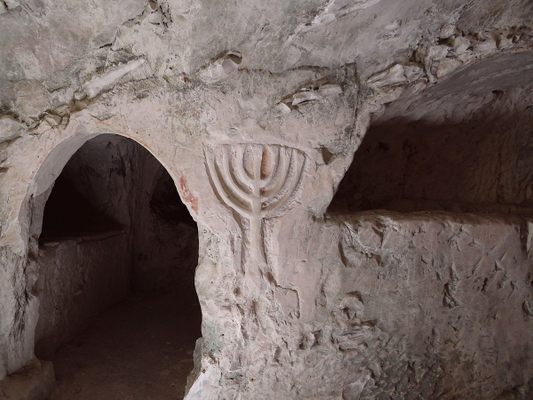About
The Roman destruction of Jerusalem's Second Temple in 70 CE scattered the Jewish people out into the empire, from the Greek islands to as far as modern-day Spain and Portugal. Following this cataclysmic event, Jerusalem's great assembly of the Sanhedrin, a sort of Supreme Court of the Jewish nation, migrated north to the Galilean city of Bet She'arim.
There's not much left of the city itself in what is now Beit She'arim National Park. At its peak in the 2nd century, however, the city was a thriving center of rabbinical Judaism. Rabbi Judah the Prince, compiler of the Mishna (a written compilation of Jewish oral tradition), made his home in Beit She'arim, assisted by a land grant from his childhood friend, the philosopher emperor Marcus Aurelius. But rather than the scattered remains of the city, what most fascinates visitors to the park is the sprawling, rock-hewn necropolis in which Rabbi Judah is buried.
More than 30 burial caves, carved into soft, white limestone, comprise what is the world's largest ancient Jewish cemetery. The existence of tombs inscribed to deceased persons from as far away as Palmyra (in modern-day Syria) and Himyar (modern-day Yemen) attest to Beit She'arim's status among the Jewish diaspora. The fact that Judah the Prince chose the site as his resting place rather than the Mount of Olives, where any devout Jew of means would have traditionally preferred to be buried, must have raised the site's prominence.
A three-arched façade guards the entrance of Beit She'arim's most impressive site, the Cave of the Coffins. Contained herein are 135 decorated coffins, as well as wall carvings, such as a human-sized sculpture of a menorah, and inscriptions in Greek, Hebrew, Aramaic, and Palmyrene.
For the Jews of Beit She'arim, the commandment of the Torah, "Thou shalt not make unto thee any graven image," was conspicuously relaxed. Adorning many of these tombs are images of lions, eagles, fish, even a dreaded calf, along with scenes from pagan mythology, such as Leda and the Swan. Experts believe presence of this imagery simply illustrates that the tolerant Jews of Beit She'arim were immersed in the Hellenistic majority culture of the time, and would have considered these figurative representations a sign of a person's prestige, not an offense to their faith.
Elsewhere on the site are the remains of an Abbasid-era glassmaking facility, as well as a poem from the same time written by the poet Umm al-Qasim, which indicates the necropolis was still in use during Muslim rule, during which time the city was known as Sheikh Ibreik.
Related Tags
Published
May 22, 2018
Sources
- https://en.wikipedia.org/wiki/Beit_She%27arim_National_Park
- https://whc.unesco.org/uploads/nominations/1471.pdf
- https://en.wikipedia.org/wiki/Second_Temple
- https://en.wikipedia.org/wiki/Siege_of_Jerusalem_(70_CE)
- https://en.wikipedia.org/wiki/Sanhedrin
- https://en.wikipedia.org/wiki/Jewish_diaspora
- https://en.wikipedia.org/wiki/Mishnah
- https://en.wikipedia.org/wiki/Thou_shalt_not_make_unto_thee_any_graven_image











































